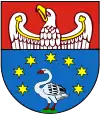Kępno
Kępno [ˈkɛmpnɔ] (![]() listen) (German: Kempen in Posen) is a town in Poland. It lies on the outskirts of the Greater Poland Voivodeship, as it borders on Silesia and the Łódz Land. As of December 31, 2009 Kępno had a population of 14,760. One popular attraction in Kępno is the recently restored Rynek (market square).
listen) (German: Kempen in Posen) is a town in Poland. It lies on the outskirts of the Greater Poland Voivodeship, as it borders on Silesia and the Łódz Land. As of December 31, 2009 Kępno had a population of 14,760. One popular attraction in Kępno is the recently restored Rynek (market square).
Kępno | |
|---|---|
_ID_651409.jpg.webp) Town hall | |
 Flag  Coat of arms | |
 Kępno  Kępno | |
| Coordinates: 51°17′N 17°59′E | |
| Country | |
| Voivodeship | |
| County | Kępno County |
| Gmina | Gmina Kępno |
| First mentioned | 1282 |
| Town rights | ca. 1283 |
| Area | |
| • Total | 7.8 km2 (3.0 sq mi) |
| Population (2016) | |
| • Total | 14,419[1] |
| Time zone | UTC+1 (CET) |
| • Summer (DST) | UTC+2 (CEST) |
| Postal code | 63-600 |
| Climate | Cfb |
| Website | http://www.um.kepno.pl |
History

The history of Kępno dates back to a medieval Polish stronghold. The oldest known mention of Kępno comes from 1282, when it was the place of signing of the Treaty of Kępno, between dukes of fragmented Poland, Przemysł II, Duke of Greater Poland and Mestwin II, Duke of Pomerania. In 1283 it enjoyed town rights.[2] Initially a royal city of Poland, in 1365 it was granted by King Casimir III the Great to knight and noble Wierzbięta z Paniewic.[2] Administratively located in the Sieradz Voivodeship in the Greater Poland Province of the Polish Crown, it became a village again.[2] It regained town rights in 1660, by decision of King John II Casimir of Poland.[2] Protestants from nearby Silesia as well as Jews settled in Kępno in the 17th century.
Kępno was annexed by the Kingdom of Prussia in the 1793 Second Partition of Poland. Administered within South Prussia from 1793 to 1807, it was part of the Napoleonic Duchy of Warsaw from 1807 to 1815. As Kempen, it was restored to Prussia in the 1815 Congress of Vienna and administered within the Grand Duchy of Posen (until 1848) and the Province of Posen, within which it was the seat of the district Kempen in Posen. The town was a 19th-century shtetl. The majority of the Jews left the city during the second half of the 19th century because of the epidemics (cholera, etc.) and the poor living conditions. They left mainly for Wrocław and surroundings, Berlin, and the Americas. Kempen (Kepno) immigrants were the first Jews to settle in Guatemala, and formed the basis of the German-Jewish community there. In the meantime, the Polish population was subject to Germanisation policies.[2] Since the mid-19th century, to resist Germanisation, Poles founded various organizations, including industrial and cultural societies, printing houses and a local branch of the "Sokół" Polish Gymnastic Society.[3] In the early 20th century local Poles protested against Germanisation policies.[4]
On 17 January 1920, after World War I, it became part of the re-established Polish Republic. Following the invasion of Poland and the outbreak of the Second World War in September 1939, Kępno was occupied by the Wehrmacht and annexed by Nazi Germany. It was renamed Kempen and administered as part of the county or district (kreis) of the same name within Reichsgau Wartheland. Its population was subject to segregation, Germanisation, confiscation of property, arrests, expulsions, deportations to forced labour, imprisonment in Nazi concentration camps and executions.[5] Polish monuments were destroyed.[6] the Polish resistance movement was organized in Kępno in November 1939.[7] Red Army troops took the town on January 21, 1945 and with the end of the war, the town returned to Poland.
Notable residents

- Wilhelm Freund (1806–1894), philologist
- Samuel Holdheim (1806–1860), reform rabbi
- Malbim (1809–1879), rabbi
- Hermann Aron (1845–1913), electrical engineer
- Gustav Jacob Born (1851–1900), histologist
- Eugen Rehfisch (1862–1937), physician
- Władysław Rabski (1865–1925), publicist, writer and member of parliament
- Edward Lasker (1885–1981), chess player
- Witold Tomczak (born 1957), politician
- Louis Phillips (1829-1900), wealthy land owner and rancher in Los Angeles, born in Kępno
Education
- Wyższa Szkoła Zarządzania "Edukacja" in Wrocław, branch in Kępno
Sports
The local football club is Polonia Kępno. It competes in the lower leagues.
Gallery
_ID_741021.jpg.webp) St. Martin's Church
St. Martin's Church The Post Office in Kępno
The Post Office in Kępno_ID_651426.jpg.webp) A historic bank building on Wawrzyniak Street
A historic bank building on Wawrzyniak Street_Travelarz.jpg.webp) The train station
The train station_ID_651421.jpg.webp) Primary school No. 1
Primary school No. 1
References
- Kowalski, Stanisław (2018). Dzieje Kępna. Od początku istnienia do 2015 r. (in Polish). Kępno.
Footnotes
- "Kępno Population". www.polskawliczbach.pl (in Polish). Retrieved 30 January 2017.
- "Historia". kepno.pl (in Polish). Retrieved 1 March 2020.
- Kowalski 2018, p. 57-61.
- Kowalski 2018, p. 59-60.
- Kowalski 2018, p. 134-135.
- Kowalski 2018, p. 134.
- Kowalski 2018, p. 137.
| Wikimedia Commons has media related to Kępno. |
